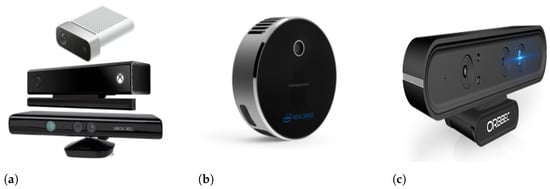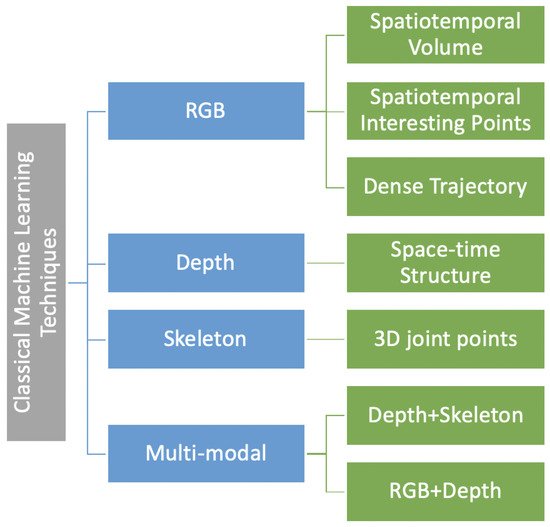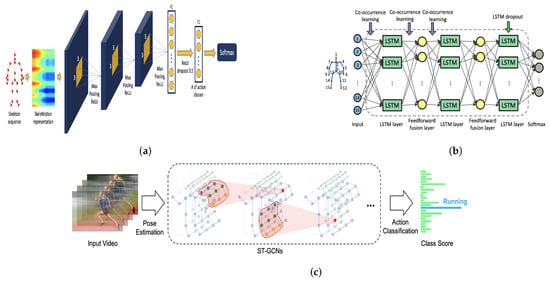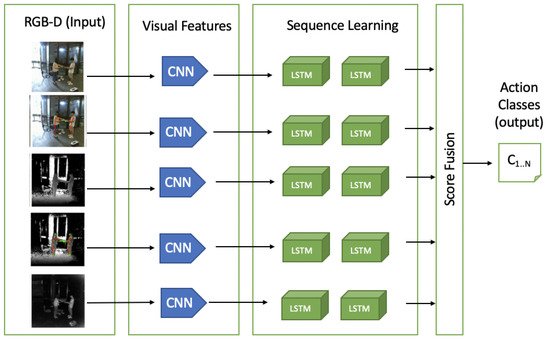1000/1000
Hot
Most Recent

Early research on Human Action Recognition was dominated by the analysis of still images or videos, localizing the actor in a video spatio-temporally using bounding boxes, temporal extent, and a spatio-temporal cuboid which contains a particular action. Human Action Recognition has many applications, including the automated annotation of user videos, indexing and retrieving user videos, automated surveillance, monitoring elderly patients using specially adapted cameras, robot operations, and live blogging of actions. In recent times, the availability of massive amounts of video data has provided significance to the understanding of video data (through a sequence of images) with the possibility of solving problems such as scene identification, searching through video content, and interaction recognition through video scenes. RGB-D generally refers to Red, Green, Blue plus Depth data captured by RGB-D sensors. An RGB-D image provides a per-pixel depth information aligned with corresponding image pixels. An image formed through depth information is an image channel in which each pixel relates to a distance between the image plane and the corresponding object in the RGB image. The addition of depth information to conventional RGB image helps improve the accuracy and the denseness of the data.
Acquisition of depth information is mainly based on triangulation and Time-of-Flight (ToF) techniques. The former technique may be implemented passively using stereovision, which retrieves depth information by capturing the same scene from different point of views. Stereovision emulates a human vision principle where depth is computed as a disparity between images taken from different viewpoints. This may require knowledge of the geometry of cameras and calibration needs to be performed for each change in system configuration. An active approach relies on structured light, which uses an IR light pattern onto the scene to estimate disparity through varying object’s depth. In addition to this, ToF and Light Detection and Ranging (LiDAR) scanners measure the time that light takes to hit an object’s surface and return to the detector. LiDAR uses mechanical components to its surrounding. However, ToF performs distance computation using integrated circuits. Chen et al. [1] and others [2] have briefly surveyed depth data acquisition in RGB-D sensors.
Most of the consumer RGB-D sensors rely on structured light or ToF approaches. Such RGB-D sensors possess noise and data distortions, which are tackled by specifically designed algorithms. Nevertheless, ToF provides a better depth resolution than the others, which is about a few millimeters. Moreover, structured light systems are not beneficial in outdoor scenarios because solar light strongly affects IR cameras. HAR tasks that do not require very high depth resolution and precision have been easily implemented using both structured light sensors and ToF devices. Such devices represented a very good compromise between cost, performance, and usability, and allowed implementation of unobtrusive and privacy-preserving solutions. Some consumer-preferred RGB-D sensors are outlined in the following subsections.
Microsoft released the Kinect RGB-D sensor, a low-cost but high-resolution tool that could be easily interfaced to a computer, and whose signals could be easily manipulated through common academic practices. The Kinect sensor V1 uses structured light, and Kinect V2 is based on ToF. The latter exhibits less software complexity but requires fast hardware, such as pulse width modulation (PWM) drivers. The Kinect technology pushed the development of depth-based algorithms and processing approaches. Kinect has been discontinued, but alternative sensors are available in the market. Azure Kinect is a recent spatial computing developer kit with computer vision and speech models, and a range of development interfaces that can be connected to Azure cognitive services. Azure Kinect is not available for consumers and thus not a replacement of Kinect. Michal et al. [3] presented a comprehensive evaluation of Azure Kinect and its comparison with both versions of Kinect. Different versions of Kinect Sensor are shown in Figure 1a (from bottom to top—Kinect v1, Kinect v2, and Azure Kinect).

Figure 1. Various RGB-D sensors: (a) Microsoft Kinect [4][5][6], (b) Intel RealSense L515 [7], and (c) Orbbec Astra Pro [8].
The Kinect sensor makes the task of capturing RGB-D data easier by sensing the depth dimension of the subject and its environment. It also interprets the movement performed by a subject and transforms it into a format that practitioners can use for new experiments. Computer vision researchers have leveraged Kinect’s vision technology for performing tasks such as aiding children to overcome autism [9] and for doctors in their operating rooms. Azure Kinect has been released for developers and industries which will potentially transform human–computer interaction in various industries including manufacturing, education [10], healthcare [11], retail [12], transportation [13], and beyond.
Intel RealSense depth cameras encompass a family of stereoscopic and portable RGB-D sensors which includes subpixel disparity accuracy, assisted illumination, and performs well even in outdoor settings. Keselman et al. [14] provided a brief overview of Intel RealSense cameras. The R400 family is successor to the R200 family that includes improvements in its stereoscopic matching algorithm and correlation cost function as well as an optimization in design, which enables the R400 family to consume lower power than R200 while operating on the same image resolutions. Intel has divided its RGB-D sensors into different categories which includes stereo depth, LiDAR, coded light, and tracking sensors. The Intel RealSense LiDAR Camera L515 [15] shown in Figure 1b is the smallest high-resolution LiDAR depth camera to date. The Intel D400 [16] series uses Active IR stereo technology. The Intel SR [17] series uses coded light technology; however, the recently introduced L series uses LiDAR technology for acquiring depth information. The L series has significantly reduced the size of the sensor, which can accelerate the use of RGB-D sensors in HAR.
Orbbec Astra sensors incorporate processor which replaces traditional cable-based connection to sensor.The Orbecc camera-computer package is economical compared to Kinect or RealSense devices. Several SDKs are available including Astra SDK (developed by the manufacturers of the sensor) and OpenNI framework for 3D natural interaction sensors. The use of different sensors in the same problem could affect the accuracy of the process. Coroiu et al. [18] demonstrated safe exchange of Kinect sensor with the Orbbec sensor. According to the experiments, over 16 classifiers demonstrated that choice of sensor does not affect the accuracy. However, seven classifiers produced a drop-in accuracy. Furthermore, calibration algorithms using different RGB-D sensor are compared in [19]. In general, RGB-D sensors exhibit acceptable accuracy, but in some cases, calibration processes are critical to increase the sensor’s accuracy and enable it to meet the requirements of such kinds of applications.
Classical machine learning-based action recognition techniques use handcrafted features and can be classified on the basis of RGB data [20], depth data [21][22], skeleton sequences [23], and methods using a combination [24] of these data modalities (as illustrated in Figure 2). Table 1 summarizes the best performing techniques which achieved benchmark accuracies for popular RGB-D datasets in action recognition research. The following subsections will discuss depth-, skeleton-, and RGB-D-based methods.

Figure 2. Hierarchy of action recognition techniques based on handcrafted features that use classical machine learning.
Table 1. Summary of popular action recognition datasets and methods that achieved the best recognition accuracy. Note that PDF stands for probability distribution function, i3D stands for inflated 3D, OF stands for Optical Flow, and GCN stands for Graph Convolutional Networks.
| Year | Ref. | Methods (Modality) | Action Datasets | MSR Daily Activity 3D [25] | UT-Kinect [26] | EPIC Kitchen-55 [27] | NW-UCLA [28] | Toyota-SH [29] | HuDaAct [30] | UTD-MHAD [31] | Charades [32] | NTU RGB-D 120 [33] | miniSports [34] | Sports-1M [35] | IRD [36][37] | HMDB-51 [38] | ICVL-4 [36][37] | NTU RGB-D 60 [39] | MSR-Action3D [40] |
|---|---|---|---|---|---|---|---|---|---|---|---|---|---|---|---|---|---|---|---|
| 2012 | [41] | 2D CNN (RGB-D) | 89 | ||||||||||||||||
| 2015 | [42] | DTQ-SVM (RGB-D) | 100 | 90 | |||||||||||||||
| 2017 | [43] | CNN (RGB-D) | 98 | 75 | |||||||||||||||
| 2018 | [37] | i3D CNN + 2D CNN (RGB-D) | 92 | 94 | |||||||||||||||
| 2019 | [44] | CNN (RGB + OF) | 56 | ||||||||||||||||
| 2019 | [34] | i3D CNN (RGB) | 74 | ||||||||||||||||
| 2019 | [45] | 3D CNN (RGB) | 75 | ||||||||||||||||
| 2019 | [36] | GCN (Skeleton) | 80 | 91 | |||||||||||||||
| 2019 | [46] | CNN (RGB) | 82 | ||||||||||||||||
| 2019 | [47] | TBN-Inception (RGB-Audio + OF) | 35 | ||||||||||||||||
| 2020 | [48] | 3D CNN + GCN (RGB-D) | 94 | 61 | 86 | ||||||||||||||
| 2020 | [49] | HAMLET (RGB-D) | 98 | 95 | |||||||||||||||
| 2020 | [50] | CNN (RGB-D) | 94 | 92 | 95 | 99 |
Motion changes in the depth maps of the human body are used to represent action. Depth data can be observed as a space–time structure which is extracted from the appearance and motion information to describe human actions. Yang et al. [51] have proposed a supernormal vector feature through a depth map sequence for action representation. Oreifej et al. [21] have proposed an orientation histogram feature of 4D normal vectors to represent the appearance information of a 3D spatio-temporal depth structure. Rehmani et al. [52] have proposed the idea of the main direction of a depth-curved surface where a perspective-independent feature and a principal component histogram are used to represent action. Yang et al. [53] have proposed the Depth Motion Map (DMM) to project spatio-temporal depth structure onto motion history maps. More recent motion history maps are represented by Histogram of Gradients (HoG) features in series to represent actions. Chen et al. [54] have used local binary features instead of HoG features; they [55] also investigated spatio-temporal depth structure from front, side, and upper directions. Miao et al. [56] have considered discrete cosine variation to compress the depth map and represent action through features using transform coefficients.
Changes in position and appearance changes in human joint points between frames are used to describe action. Xia et al. [26] have modeled action through a discrete hidden Markov model. Action features have also been extracted through 3D Histograms of Oriented Displacements (HoD) [57], Accumulation of Motion Energy (AME) function aided with the Eigenjoint-based method [23], and through a longest common sequence algorithm [58] to select high-discriminative power features from the relative motion trajectories of the skeleton.
The research results in [22][52][59] show that depth-based methods achieve better action recognition performance than RGB-based methods. Therefore, some researchers have also tried a fusion of different modalities. Chaaroui et al. [60] have investigated the fusion of skeleton and depth data to overcome problems caused by occlusion and perspective changes in skeleton features. In addition, a sparse regression learning-based method to fuse depth and skeleton features has been proposed by Li et al. [24]. A multi-kernel-based learning method for describing actions has been proposed by Althloothi et al. [61]; they calculated spherical harmonics through depth data and fused this with the spatial information of skeleton joints. Furthermore, RGB and depth data fusion has also been attempted by some researchers. For example, Liu et al. [62] used generic algorithms, Jalal et al. [63] merged spatio-temporal features, and Ni et al. [64] introduced the multi-level fusion of RGB and depth data features. However, to answer the missing modality problem, Kong et al. [65] have proposed a discriminative relational representation learning (DRRL) method. In the absence of a single modality in testing, this method transfers knowledge from training data to substitute the missing modality and achieves better recognition performance. The main concern with RGB-D data fusion is that it adds more computational complexity to the action recognition algorithm. Yu et al. [66] have proposed a binary representation for RGB-D data fusion with structure-preserving projections. This approach produced high efficiency and effectiveness on various action recognition benchmarks of RGB-D data.
Computer vision researchers have directed considerable attention to the application of deep learning in action recognition. The classical machine learning-based methods are based on handcrafted features, which are not robust. Deep learning-based methods have been utilized due to their automated feature learning from images. Researchers have extracted action features from RGB data, depth data, and skeleton sequences using deep learning methods. The following subsections discuss the fundamental variants of neural networks, and later we present some modern deep learning-based approaches used in RGB-D data.
Recent successes in deep neural networks have boosted research in pattern recognition and computer vision. Some commonly used variants of neural networks are briefly outlined in following subsections.
CNNs represent one of the most notable deep learning approaches, where they have been highly effective in a variety of computer vision applications. CNNs are good at recognizing patterns in Euclidean data, i.e., images, text, and videos. CNN works with a mathematical function called convolution, which is a special kind of linear operation. In convolution, input neurons are multiplied with a set of weights that are commonly known as filters or kernels. The filters act as a sliding window across the whole image and enable CNNs to learn features from neighboring cells. Within the same layer, the same filter will be used throughout the image, this is referred to as weight sharing. For example, using a CNN to classify images of dogs vs. non-dogs, the same filter could be used in the same layer to detect the nose and the ears of the cat. There are four basic ideas behind CNN that benefit from the characteristics of natural signals: local connections, shared weights, pooling, and the use of many layers [67]. These four key ideas can be labeled as the Convolution layer, Rectified Linear Unit (ReLU) layer, Pooling, and Fully Connected (FC) Layer, respectively. An example of CNN architecture is presented in Figure 3a, originally shown in [68].

Figure 3. Illustration of deep learning techniques for processing RGB-D data. (a) Convolutional Neural Network (CNN). (b) Long Short-Term Memory (LSTM). (c) Graph Convolutional Network (GCN).
The Recurrent Neural Network (RNN), Auto-Associative, or Feedback Network is a type of neural network that has variants including Gated Recurrent units. RNNs have been quite successful in conducting tasks like speech recognition, caption generation, machine translation, image/video classification, human dynamics, and action recognition, among other applications. The RNN function is an alternative to CNN; the RNN function is good at learning dependencies among spatially correlated data like image pixels [69]. RNN cannot store information for a longer duration. Long Short-Term Memory (LSTM) is a special kind of RNN capable of learning temporal relationships on a long-term scale. LSTM [70] uses a gates mechanism: write (input gate), read (output gate), and reset (forget gate), where this gates mechanism controls the behavior of its memory cells. The use of LSTM has produced effective results in speech recognition, especially in phoneme recognition. However, learning with LSTM is often challenging in real-time sequences [71]. An example of LSTM architecture is presented in Figure 3b, originally shown in [72].
Earlier variants of neural networks are implemented using regular or Euclidean data. However, real-life data have a graph structure that is non-Euclidean. Therefore, the non-regularity of data structures has led to advancements in graph neural networks. Graph Convolutional Networks (GCN) are also considered as one of the basic Graph Neural Networks variants. Convolution in GCNs is the same operation as in CNNs. GCNs [73] are an efficient variant of CNNs on graphs. In GCNs, the model learns from the neighboring nodes by stacking layers of learned first-order spectral filters followed by a nonlinear activation function to learn graph representations. For simplicity, GCNs take a graph with some labeled nodes as input and generate label predictions for all graph nodes. GCNs could be divided into two approaches: Spatial GCNs and Spectral GCNs. An example of GCN is presented in Figure 3c, originally shown in [74].
Deep learning can directly obtain hierarchical features from different data modalities and provides a more effective solution. Accordingly, appearance and optical sequences can be used as inputs to deep networks. Besides aspects of appearance and motion information, deep learning-based methods can also be applied using depth sequences and skeleton joint information. Wang et al. [75] have used convolution to learn action features from depth data. They [76] combined motion and structure information in a depth sequence by pairing structured dynamic images at the body, part, and joint levels through bidirectional rank pooling. Every pair is constructed from depth maps at each granularity level and serves as input to CNN. Song et al. [77] have proposed a model that uses different levels of attention in addition to an RNN with LSTM to learn discriminative skeleton joints. Ye et al. [78] have embedded temporal information with dense motion trajectories to learn actions.
Yan et al. [68] have modeled relationships between graphs and joints by using a graph-oriented CNN. Deep learning-based feature learning has been shown to provide better performance than handcrafted feature extraction methods; however, there are still challenges concerning RGB-D data fusion. Deep learning-based action recognition methods use different standalone as well as hybrid neural network architectures, which can be classified as Single-Stream, Two-Stream, Long-term Recurrent Convolutional Network (LRCN), and Hybrid network-based architectures. The following subsections summarize these architectural styles.
A single-stream model is similar to the AlexNet [79] type of image classification network. Single-stream architecture can take advantage of regularization through local filters, parameter sharing at convolution layers, and local invariance building neurons (max pooling). Such neural network architecture shifts the engineering focus from feature design strategies to network structure and hyperparameter tuning strategies. Architectural details from AlexNet [79] can be used with different hyperparameter configurations. A single-stream architecture fuses information from all the frames in the softmax layer connected to the last fully connected layers with dense connections. Given an entire action video, the video-level prediction can be produced by forward propagation of each frame individually through the network and then averaging individual frame predictions over the duration of the video. However, single-stream architecture has been a foundation for other extended architectures. Some possible extensions to single-stream architecture have been explored by Baccouche et al. [80], Ji et al. [81], and Karpathy et al. [35].
The two-stream model uses two disjointed CNNs containing spatial and temporal information, which are later fused together. The spatial network performs action recognition from single video frames, while the temporal network learns to recognize action from motion, i.e., dense optical flow. The idea behind this two-stream model relates to the fact that the human visual cortex contains two pathways for object and motion recognition, i.e., the ventral stream performs object recognition and the dorsal stream recognizes motion. Spatial-stream CNN is modelled similar to the single-frame model discussed earlier. Given an action video, each frame is individually passed through the spatial network where an action label is assigned to each frame. The temporal-stream CNN is not the same as motion-aware CNN models (which use stacked single video frames as input). It takes stacked optical flow displacement fields between several consecutive frames as input to explicitly learn a temporal feature.
In two-stream models, the pioneering work of Simonyan and Zisserman [82] uses a single image and multi-optical flow sequence stack as input to the 2D CNN. Zhang et al. [83] have extended Simonyan and Zisserman’s [82] work by using a motion vector instead of optical flow as an input to improve performance and comprehend real-time action recognition. Feichtenhoer et al. [84] have proposed an innovative approach involving moving the classification layer to the middle of the network for spatio-temporal information fusion, and this was shown to improve the accuracy. Wang et al. [85] have contributed to the input and training strategy of convolution and proposed Temporal Segment Network (TSN), improving the two-stream CNN. The notion of TSN was based on long-range temporal structural modeling. Later, Lan [86] and Zhou [87] enhanced the TSN. Carreira et al. [88] adopted the structure of Inception-v1 and inflated two-stream CNN to 3D CNN for action recognition. Zhu et al. [89] have expanded two-stream CNN to a 3D structure by drawing out the pooling operation.
LRCN uses CNN in co-ordination with an LSTM-based network. In LSTM-based deep learning methods, actions can be represented as feature changes between frames in the video, LSTM is widely used to improve action recognition techniques. Ng et al. [90] have presented a linear RNN for recognizing human actions that connects the output of a CNN with an LSTM cell. A new architecture—P3D ResNet—has been proposed by Qiu et al. [91], which uniquely places all the variants of blocks in a different placement of ResNet. In skeletal data, to deal with noise, Liu et al. [92] extended the idea to analyze spatio-temporal domains simultaneously by introducing an effective tree structure-based traversal framework. This framework uses a cross-modal feature fusion strategy within LSTM unit and a gating mechanism to learn the reliability of sequential data in long-term context representation. For mapping video frames with variable length inputs to variable length outputs, Donahue et al. [93] have proposed an LRCN. Unlike those methods that learn CNN filters based on a stack of a fixed number of input frames, LRCN [93] is not constrained to fixed-length input frames and thus can learn to recognize more complex action video. As illustrated in Figure 4 (RGB-D input visuals taken from the work in [33]), individual video frames are first passed through CNN models with shared parameters and are then connected to a single-layer LSTM network. More precisely, the LRCN model combines a deep hierarchical visual-feature extractor, i.e., a CNN feature extractor, with an LSTM that can learn to recognize temporal variations in an end-to-end fashion.

Figure 4. A possible architecture of LRCN with RGB-D input. Input from each modality, i.e., RGB, RGB + Skeleton joints, Depth, Depth + Skeleton joints, and IR are passed through a CNN layer for extracting visual features and an LSTM layer for sequence learning. Scores from each model are then fused and mapped to the number of classes for predictions. Visuals of RGB-D input are taken from NTU RGB-D 60 dataset [39].